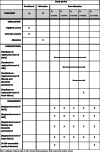The effect of automated audit and feedback on data completeness in the electronic health record of the general physician: protocol for a cluster randomized controlled trial
- PMID: 33947448
- PMCID: PMC8097814
- DOI: 10.1186/s13063-021-05259-9
The effect of automated audit and feedback on data completeness in the electronic health record of the general physician: protocol for a cluster randomized controlled trial
Abstract
Background: The electronic health record (EHR) of the general physician (GP) is an important tool that can be used to assess and improve the quality of healthcare. However, there are some problems when (re) using the data gathered in the EHR for quality assessments. One problem is the lack of data completeness in the EHR. Audit and feedback (A&F) is a well-known quality intervention that can improve the quality of healthcare. We hypothesize that an automated A&F intervention can be adapted to improve the data completeness of the EHR of the GP, more specifically, the number of correctly registered diagnoses of type 2 diabetes and chronic kidney disease.
Methods: This study is a pragmatic cluster randomized controlled trial with an intervention at the level of GP practice. The intervention consists of an audit and extended electronically delivered feedback with multiple components that will be delivered 4 times electronically to general practices over 12 months. The data will be analyzed on an aggregated level (per GP practice). The primary outcome is the percentage of correctly registered diagnoses of type 2 diabetes. The key secondary outcome is the registration of chronic kidney disease. Exploratory secondary outcomes are the registration of heart failure, biometric data and lifestyle habits, and the evolution of 4 different EHR-extractable quality indicators.
Discussion: This cluster randomized controlled trial intends to primarily improve the registration of type 2 diabetes in the EHR of the GP and to secondarily improve the registration of chronic kidney disease. In addition, the registration of heart failure, lifestyle parameters, and biometric data in the EHR of the GP are explored together with 4 EHR-extractable quality indicators. By doing so, this study aims to improve the data completeness of the EHR, paving the way for future quality assessments.
Trial registration: ClinicalTrials.gov NCT04388228 . Registered on May 14, 2020.
Conflict of interest statement
The authors declare that they have no competing interests.
Figures
Similar articles
-
A Behavioral Economics-Electronic Health Record Module to Promote Appropriate Diabetes Management in Older Adults: Protocol for a Pragmatic Cluster Randomized Controlled Trial.JMIR Res Protoc. 2021 Oct 27;10(10):e28723. doi: 10.2196/28723. JMIR Res Protoc. 2021. PMID: 34704959 Free PMC article.
-
Facilitating advance care planning in the general practice setting for patients with a chronic, life-limiting illness: protocol for a phase-III cluster-randomized controlled trial and process evaluation of the ACP-GP intervention.BMC Palliat Care. 2021 Jun 25;20(1):97. doi: 10.1186/s12904-021-00796-1. BMC Palliat Care. 2021. PMID: 34172030 Free PMC article.
-
Machine learning optimization of an electronic health record audit for heart failure in primary care.ESC Heart Fail. 2022 Feb;9(1):39-47. doi: 10.1002/ehf2.13724. Epub 2021 Nov 23. ESC Heart Fail. 2022. PMID: 34816632 Free PMC article.
-
Development of quality indicators for type 2 diabetes, extractable from the electronic health record of the general physician. A rand-modified Delphi method.Prim Care Diabetes. 2020 Feb;14(1):75-84. doi: 10.1016/j.pcd.2019.05.002. Epub 2019 Jun 14. Prim Care Diabetes. 2020. PMID: 31204263 Review.
-
Automating Electronic Health Record Data Quality Assessment.J Med Syst. 2023 Feb 13;47(1):23. doi: 10.1007/s10916-022-01892-2. J Med Syst. 2023. PMID: 36781551 Free PMC article. Review.
Cited by
-
Methodology paper for the General Medicine Inpatient Initiative Medical Education Database (GEMINI MedED): a retrospective cohort study of internal medicine resident case-mix, clinical care and patient outcomes.BMJ Open. 2022 Sep 23;12(9):e062264. doi: 10.1136/bmjopen-2022-062264. BMJ Open. 2022. PMID: 36153026 Free PMC article.
-
The impact of the Covid-19 pandemic on the incidence of diseases and the provision of primary care: A registry-based study.PLoS One. 2022 Jul 6;17(7):e0271049. doi: 10.1371/journal.pone.0271049. eCollection 2022. PLoS One. 2022. PMID: 35793324 Free PMC article.
-
Enhancing Data Completeness in Early Detection Pathway of Prostate Cancer: Integration of a Dashboard-Driven Feedback Tool to Improve Quality of Care.J Clin Med. 2024 Dec 11;13(24):7529. doi: 10.3390/jcm13247529. J Clin Med. 2024. PMID: 39768452 Free PMC article.
-
The Impact of the COVID-19 Pandemic on the Registration and Care Provision of Mental Health Problems in General Practice: Registry-Based Study.JMIR Public Health Surveill. 2023 Mar 10;9:e43049. doi: 10.2196/43049. JMIR Public Health Surveill. 2023. PMID: 36599160 Free PMC article.
References
Publication types
MeSH terms
Associated data
LinkOut - more resources
Full Text Sources
Medical


